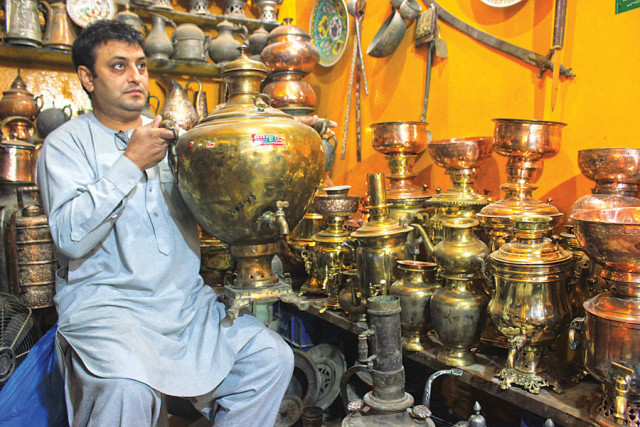‘Living art’: New gallery features expensive antiques from city’s rich past
Household antiques speak volumes about the region’s cultural heritage.

Tucked away in a busy bazaar near the historical Ghanta Ghar clock tower, Zaitoon features an array of collectables, including large Russian and Kashmiri samovars, jugs crafted from brass, silver as well as iron, hand-painted enamel serving dishes and wooden furniture. PHOTOS: MUHAMMAD IQBAL/EXPRESS
For locals, Zaitoon Art Gallery may offer little more than rusty household items from the distant past, but to those who value cultural heritage there is nothing mundane about the antiques displayed at the recently inaugurated modest art space.
Situated near the historical Ghanta Ghar clock tower, Zaitoon features an array of collectables, including large Russian and Kashmiri samovars (traditionally used to heat water and make tea), jugs crafted from brass, silver as well as iron, hand-painted enamel serving dishes and wooden furniture.

The gallery’s owner, Javaid Naseem, was inspired by the need to preserve and celebrate the area’s rich heritage. One of the world’s oldest cities, Peshawar has historically been influenced by the Gandhara, Pukhtun and Hindko cultures. It was also a prosperous trade route in Asia over the centuries and the foreign antiques lining Zaitoon’s walls pay testament to this cultural heritage.
Naseem characterised these as ‘living art’. Each antique was both functional and ornamental.
According to him, these teapots and water dispensers formed an integral part of the daily life of generations passed and spoke volumes about local heritage.

Many of Zaitoon’s treasures hail from the magnificent living quarters of the prosperous Sethi family, which belonged to Peshawar’s trading class between the 18th and 20th centuries. There are seven Sethi havelis spread across Peshawar.
“The Sethis had links to other countries and brought many things from regions like Kashmir and Central Asia,” said Naseem.
Unfortunately, much of the craftsmanship behind these treasures has disappeared but there are some like Jan Gul Ustad who still adopt old techniques when working with various metals. He embosses metal objects with a hammer and chasing tools.
Naseem explained that enameling metal objects had a dual purpose. It prevented the contents of the container (jug, bowl etc.) from spoiling and exuding an odour and the enamel also added aesthetic value.

He said that these antiques were luxury items inaccessible to ordinary people due to the steep cost. As it is, not many residents would have practical use for these products. They are mostly stored and displayed in art galleries or exported to other countries where the demand for antique art is higher.
Some of these items, such as the Kashmiri samovars, are listed on the classified website, olx.com, for Rs20,000.
“There is a great demand for such products in Thailand, China, Japan, and Central Asian countries,” said Naseem.
In the recent past, foreigners such as diplomats and tourists would buy these pieces but due to the security situation very few people from abroad frequent this ancient city.
Published in The Express Tribune, March 21st, 2014.













COMMENTS
Comments are moderated and generally will be posted if they are on-topic and not abusive.
For more information, please see our Comments FAQ